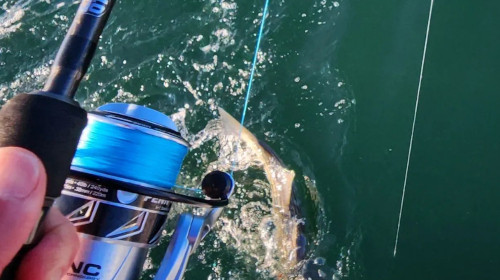Jigging & Popping Rigging Tips - Part 3: Line, Leader & Accessories
Posted by OTI on Jun 20th 2023

At Ocean Tackle International, we understand the importance of selecting the right line, leader, and accessories for jigging and popping. Check out these tips to enhance your experience.
Line, Leader & Accessories
Choosing the right line and leader material can greatly impact your success, and we'll discuss the pros and cons of solid and hollow spectra lines, as well as the importance of wind-on leaders for seamless transitions. Additionally, we'll delve into the importance of selecting the right tools and accessories, including split ring pliers, gloves, and fighting belts or plates. So, whether you're a seasoned angler or new to the world of jigging and popping, read on to discover valuable insights that will help you optimize your rigging setup and increase your chances of landing that trophy catch!
Line and Leader Material
When it comes to spectra lines, you have two main options: solid or hollow. The choice between the two ultimately depends on personal preference, budget, and intended use. For popping, we generally recommend using hollow spectra lines. For jigging, we would recommend solid metered braid.
To ensure a seamless and knotless transition from the main line to the leader, we highly recommend using a spliced loop coupled with a wind-on leader specifically designed for jigging and popping. This combination maintains 100% breaking strength while providing exceptional performance. Even though casting distance is not a primary concern during jigging, we still recommend using wind-ons. For the connection, we suggest tying a small Bimini twist or spider hitch loop at the end of the mainline. Metered lines are particularly beneficial for jigging as they allow you to drop your jig to a precise depth and keep it within the desired strike zone.
When it comes to leaders, we prefer using Jinkai leader material for both wind-on and tied leaders. Jinkai leader material offers exceptional softness and has minimal memory, ensuring superior performance. Depending on your preferences, you may opt for a short bite leader that offers increased abrasion resistance or fluorocarbon leader material. However, in our experience, a full-length fluorocarbon leader is not always necessary for jigging and popping. Since strikes during these techniques are often violent and reaction-driven, the sensitivity and casting distance provided by a shorter leader are more than sufficient.
Tools and Accessories
In addition to selecting the right line and leader material, having the proper tools and accessories is crucial. One indispensable tool is a reliable pair of split ring pliers. Look for pliers with a wide front tooth and high-quality cutters that can effortlessly slice through spectra lines without fraying the ends.
Considering the active nature of jigging and popping, it's important to protect your hands. Gloves play a significant role in shielding your hands from the reel handle, which can cause blisters, as well as spectra lines that have the potential to cut deep into your fingers and hands. Wearing gloves will not only keep your hands safe but also enhance your overall fishing experience, allowing you to stay on the rail longer and enjoy your trips to the fullest.
Fighting belts and plates can be a bit challenging when it comes to this type of fishing. Many gimbal plates available on the market are designed for use with more traditional gear and may require modifications or even replacement when jigging or popping. To address this, we recommend selecting lightweight plates that offer a larger side cup in addition to the gimbal pin. These plates should allow for a longer butt section without stretching your arms uncomfortably.
It is crucial to know when to use your gimbal plate and when not to. Leaving your gimbal in the belt can lead to high-sticking your rod when the fish is near the boat. High sticking, which involves holding the rod at an angle that puts excessive stress on it, is the primary cause of rod failure, and it often occurs right at the boat. We will delve deeper into fighting techniques in a subsequent section, but it is essential to remove your gimbal from the plate when the fish is nearing the boat to avoid this issue.

